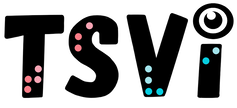- Home
-
Learn
- History of VI >
- Legislation & Laws >
- Vision Professionals >
-
VI Program Resources
>
- Program Printables
- Itinerant Teaching Tips
- Year at a Glance
- VI Program Handbook
- Caseload Analysis
- Organization & Time Management
- Professional Development
- Teacher Standards
- Professional Ethics
- Awards & Recognition
- APH Scholar Program
- Professional Organizations
- Certification Organizations
- Dealing with Challenges
- Professional Publications >
- Relatable Books for All Ages >
- Family Resources >
- Plan
- Basics
-
Teach
- Teaching Strategies >
-
Compensatory Skills Instruction
>
-
Social Skills
>
-
Self Determination
>
- Body Image & Acceptance
- Making Personal Goals
- My Vision Presentation
- My Self-Description
- Create a Personal Data Sheet
- Disclosure Decision
- Disability Statement
- Requesting Help
- Fighting Fears
- My Circle of Support
- Personal Responsibility
- Advocate for Safe Enviroments
- Having Picture Taken
- Coping with Change
- Aging Eyes
- Physical Characteristics
- Political Activism
- Laws Regarding Persons with Disabilities
-
Sensory Efficiency
>
-
Independent Living
>
- Orientation & Mobility Instruction >
- Recreation & Leisure >
-
Career & Vocation
>
-
Grow
- Complete Set Bonus >
-
Recorded Presentations
>
- Webinar: Tips for Being a "Physically Fit" TVI
- Webinar: The Art of Teaching the ECC
- Webinar: Virtual & F2F Strategies
- Webinar: Foundations of Teaching the ECC in the Age of Virtual Instruction
- Webinar: Itinerant Teaching Strategies
- Webinar: Using Themes to Teach the ECC
- Webinar: Conducting a FVLMA
- Webinar: Selecting the Right AT
- Webinar: Developing SMARTER Goals
- Webinar: Determining Service Intensity Using the VISSIT
- Webinar: Activities to Teach the ECC
- Webinar: Accessible Content for BLVI
- Webinar: Accommodations for VI
- Webinar: MIMO Strategies & Activities
- Webinar: SIDPID Strategies & Activities
- Webinar: Standard Course of Study Strategies & Activities
- Webinar: Job Tasks for Job, Career & Life
- Shop
- Jobs
FVLMA Kit Materials
By: Carmen Willings
teachingvisuallyimpaired.com Updated March 11, 2018 When assembling materials for a Functional Vision Assessment Kit, it is generally a good idea to plan to have two assessment kits. The first kit can be designed for students that are pre-readers and for those with multiple disabilities. The other kit can contain a variety of materials that reflect different age and reading levels. The kits should include both formal and informal tools to assess vision. FVE Kit for Readers1. Writing Tools:
2. Reading Tools:
3. Distance Eye Charts:Good Lite Lea Symbols Distance Chart
I have used the Lea Symbol charts frequently as they can be used with readers and pre-readers. The response card is very helpful when working with pre-readers as well as non-verbal students as the student can point to the picture that they see. Good Lite LEA Distance Vision Screener Flipchart
This distance vision eye chart is helpful when assessing students that have difficulty with visual clutter as only one line is presented at a time. The LEA symbols can be used with pre-readers and readers. Good Lite HOTV Distance Folding Chart
Older, academic students, may be insulted if they are presented with the Lea Symbols. For this reason, it is beneficial to also have either HOTV symbols or numbers acuity charts. 4. Near Visual Acuity:
Good Lite Lea Symbols
This is a good tool to use with students who can read as well as students who are pre-readers or emergent readers. Lea Numbers Near Vision Card The Lea Numbers can be used with students who know their numbers. Sloan Letter Near Vision Eye Chart
A sloan letter near vision eye chart can be used to assess a student who can readily identify letters. 5. Color Vision Testing
Color Vision Testing Made Easy
This assessment tool is great for assessing student's color vision. It uses simple, easy to recognize symbols and can be used with students as young as preschoolers that know their shapes. 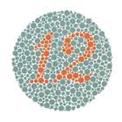
The Pseudo Chromatic Color Test app, a free app on the iTunes store, can be used as part of the color vision portion of the Functional Vision Assessment. The app can pick up on any difficulties the student may have and it also provides information on how to interpret the results.
Paint Swatches. Another strategy is to obtain a selection of paint swatches in various color hues. Cut the swatches in half and encourage the student to locate the matches.
6. Miscellaneous Items:
Functional Vision Assessment Kit for Pre-Readers
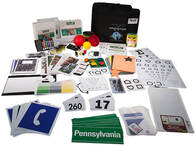
The NewT Kit from APH provides the majority of tools you will need to complete a FVE/LMA assessment. It includes acuity charts; photos, colored pictures and line drawings to match and sort; an array of environmental print and reading passages; and more!
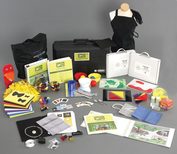
The ToAD kit from APH provides tools, toys, and puzzles that assist the educator as he or she performs assessments or activities. In addition to its uses for assessment and for vision development activities, ToAD serves as the Vision Modality for the Sensory Learning Kit.
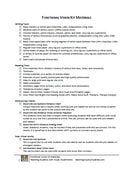
I developed this FVE Kit material list, available on the Printables page, as a quick reference to use when putting together items for a FVE kit. Select materials that are age appropriate, developmentally appropriate and gender neutral.
|
History of Visual Impairments
Professional Practice
Vision Professionals
Professionalism
Teacher Resources
Professional Publications
VI Book Resources
Family Resources
VI Referrals
Medical vision exams
visual diagnosis
fvlma
|
|
Teaching Students with Visual Impairments LLC
All Rights Reserved |
- Home
-
Learn
- History of VI >
- Legislation & Laws >
- Vision Professionals >
-
VI Program Resources
>
- Program Printables
- Itinerant Teaching Tips
- Year at a Glance
- VI Program Handbook
- Caseload Analysis
- Organization & Time Management
- Professional Development
- Teacher Standards
- Professional Ethics
- Awards & Recognition
- APH Scholar Program
- Professional Organizations
- Certification Organizations
- Dealing with Challenges
- Professional Publications >
- Relatable Books for All Ages >
- Family Resources >
- Plan
- Basics
-
Teach
- Teaching Strategies >
-
Compensatory Skills Instruction
>
-
Social Skills
>
-
Self Determination
>
- Body Image & Acceptance
- Making Personal Goals
- My Vision Presentation
- My Self-Description
- Create a Personal Data Sheet
- Disclosure Decision
- Disability Statement
- Requesting Help
- Fighting Fears
- My Circle of Support
- Personal Responsibility
- Advocate for Safe Enviroments
- Having Picture Taken
- Coping with Change
- Aging Eyes
- Physical Characteristics
- Political Activism
- Laws Regarding Persons with Disabilities
-
Sensory Efficiency
>
-
Independent Living
>
- Orientation & Mobility Instruction >
- Recreation & Leisure >
-
Career & Vocation
>
-
Grow
- Complete Set Bonus >
-
Recorded Presentations
>
- Webinar: Tips for Being a "Physically Fit" TVI
- Webinar: The Art of Teaching the ECC
- Webinar: Virtual & F2F Strategies
- Webinar: Foundations of Teaching the ECC in the Age of Virtual Instruction
- Webinar: Itinerant Teaching Strategies
- Webinar: Using Themes to Teach the ECC
- Webinar: Conducting a FVLMA
- Webinar: Selecting the Right AT
- Webinar: Developing SMARTER Goals
- Webinar: Determining Service Intensity Using the VISSIT
- Webinar: Activities to Teach the ECC
- Webinar: Accessible Content for BLVI
- Webinar: Accommodations for VI
- Webinar: MIMO Strategies & Activities
- Webinar: SIDPID Strategies & Activities
- Webinar: Standard Course of Study Strategies & Activities
- Webinar: Job Tasks for Job, Career & Life
- Shop
- Jobs
